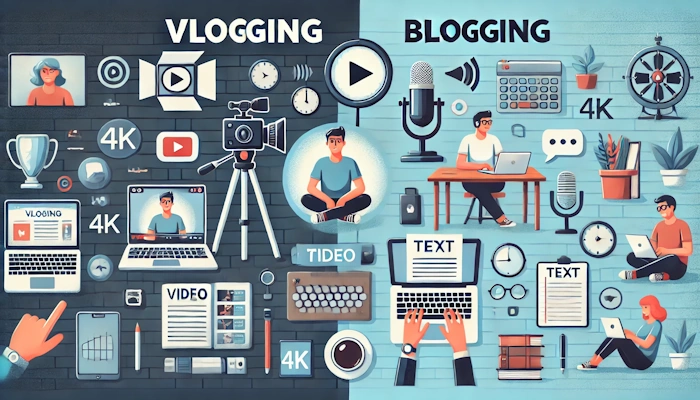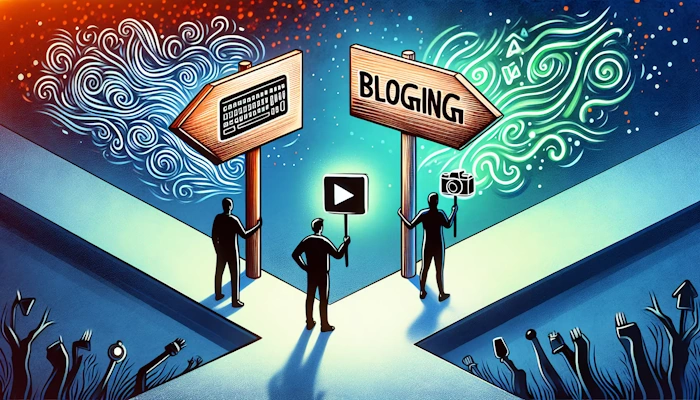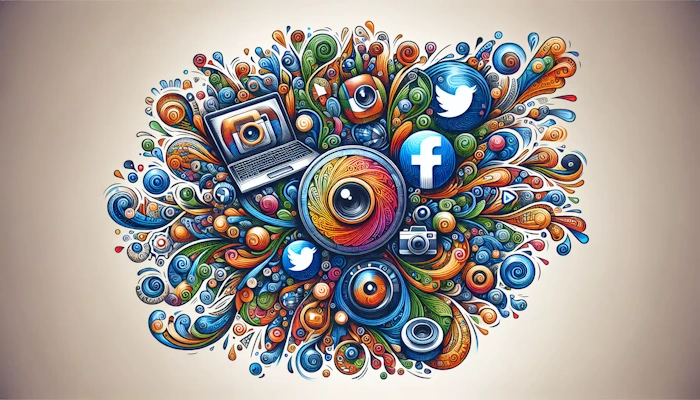Blogger vs Vlogger: Which is the Right Choice for You?

Are you pondering whether to start vlogging or blogging? Let’s cut through the noise. In this article, you’ll get straight answers about the distinctions, skills required, and monetization potential for each platform, helping you decide which is the best fit for your online presence.
Whether you are passionate about writing or creating videos, your choice should align with your interests to ensure long-term success in content creation. Both bloggers and vloggers have the potential to make more money through various monetization strategies such as in-content adverts, affiliate links, and YouTube payments.
Key Takeaways
Vlogging is a video-based format requiring equipment and editing skills, fostering a personal connection with the audience, while blogging focuses on nuanced storytelling through written content, more accessible for beginners.
Content creators must consider audience demographics, engagement dynamics, and technical demands when deciding between vlogging and blogging—each platform suits different content types and personal branding strategies.
Both platforms require strategic planning and skill development, with SEO optimization for discoverability and effective monetization strategies, such as advertising revenue and sponsorships, to create a sustainable online presence.
Vlogging vs. Blogging: Understanding the Core Differences
In the world of content sharing, the “blog vs vlog” debate often arises, as both vlogging and blogging, though similar in their goals, diverge significantly in their execution and audience engagement. At their core, the main difference lies in the medium used: vlogs, or video logs, rely on video content, while blogs are built on written content. This foundational difference influences every aspect of video and blog content creation, from the skills required to the way audiences interact with the material.
Vlogs usually foster a more personal connection when we discuss interaction and engagement. The visual and auditory presence of the creator in a vlog creates a sense of intimacy and immediacy that written content may lack. On the other hand, blogs provide a platform for detailed and nuanced storytelling that can be deeply engaging in its own right, especially when complemented by images or other multimedia elements.
There’s also a significant variation in the technical demands for each medium. Vlogging often requires a higher initial investment in equipment like cameras and video editing software, along with the technical skills to use them effectively. Blogging, meanwhile, primarily demands strong writing skills and access to a computer with an internet connection, making it more accessible for beginners.
Content Mediums Explored for Video Content or Blogging
Different styles of content consumption are catered to by blogs and vlogs. Blogs are predominantly composed of written content such as articles, stories, or essays. These can be enhanced with multimedia elements like photos, videos, and infographics to add depth and visual interest. The consumption process for blog content involves reading and scrolling through text and images, which allows readers to engage with the content at their own pace.
Video blogging, or vlogging, is a practice that involves creating and sharing video content as part of online expression and knowledge sharing. Unlike traditional blogging, which relies on text, video blogging uses video to convey messages and engage audiences.
On the other hand, vlogs are inherently multimedia and depend on video content to deliver their message. This video format combines visual and auditory elements to create a dynamic and immersive experience for the viewer. Watching a vlog typically involves both seeing and hearing the creator, which can make the content feel more immediate and engaging.
Each medium serves different purposes and appeals to different audience preferences. While blogs allow for in-depth exploration of topics through written content, vlogs excel in presenting information in a visually engaging and often more immediate manner. Deciding which platform best aligns with the content you want to create requires understanding these differences.
Interaction and Engagement Dynamics
In terms of audience engagement, vlogs offer a unique advantage. The presence of the creator in the video allows for a more personal and direct connection with the audience. This visual and auditory engagement can make viewers feel as though they are having a conversation with the vlogger, fostering a stronger sense of community and loyalty. Additionally, the shareability of video content on social media platforms can amplify this engagement, making vlogs more likely to go viral compared to blog posts. Bloggers and vloggers utilize social media platforms to share their content, engage with their audience, and expand their reach.
Despite potentially being less engaging due to the lack of visual and auditory elements, blogs can still promote deep engagement with well-crafted written content. Detailed articles, thoughtful essays, and the inclusion of multimedia elements can create a rich experience that resonates with readers. The engagement here is more about reflection and thought, which can be very powerful in its own right.
Technical Demands and Skills
Vlogging generally requires a steeper learning curve and higher initial investment. High-quality video production necessitates proficiency in video editing and the use of specialized software like Adobe Premiere Pro or Final Cut Pro. Moreover, vloggers need to invest in equipment such as high-quality cameras, microphones, and lighting to ensure their videos are professional and engaging.
In contrast, the technical barriers to starting a blog are significantly lower. A computer with an internet connection is often all that’s needed to get started. Blogging does, however, demand strong writing skills to create compelling content that engages readers. While the initial setup might be simpler, maintaining a successful blog requires consistent effort and creativity in writing.
Crafting Your Message: Vlog or Blog?
Choosing between a vlog and a blog involves considering your goals, skills, and the type of content you wish to create. Each platform offers distinct advantages depending on the nature of your message and the preferences of your target audience. For instance, if your content is highly visual or requires demonstration, a vlog might be more effective. Conversely, if your content is detailed and analytical, a blog could be the better choice.
It’s also important to consider how each platform aligns with your personal branding and storytelling approach. Both mediums can be powerful tools for building a personal brand, but they do so in different ways. Vlogs offer a more immediate and personal connection, while blogs provide a space for more in-depth exploration of ideas.
Matching Platform to Content Type
Certain types of content naturally lend themselves to specific platforms, such as video blogs. Vloggers create videos, which is a key distinction from bloggers who focus on written content. Popular vlog types include:
beauty tutorials
gaming streams
travel diaries
technology reviews
These formats allow creators to demonstrate products, share experiences, and connect with their audience in a lively and interactive way.
Blogs, on the other hand, are well-suited for delivering detailed, informative, and complex content. Tutorials, guides, thought leadership pieces, and in-depth analyses are examples of content that can thrive on a blog. These pieces benefit from the structured, reflective nature of written content, allowing readers to absorb and contemplate the information at their own pace.
Personal Branding and Storytelling When Vlogging or Blogging
Personal branding and storytelling are crucial elements for success in both blogging and vlogging. Storytelling helps establish trust, credibility, and a memorable identity in the digital space. Sharing personal narratives that highlight unique qualities and experiences can significantly enhance your brand, whether through blog posts or vlogs.
Authenticity is key. Stories that align with your personal brand’s values resonate more deeply with your audience, helping to forge stronger connections. Both vloggers and bloggers face challenges like self-doubt and the pressure to maintain a certain image, but overcoming these challenges is part of building a compelling personal brand.
Audience Considerations
Understanding your audience demographics is vital when choosing between vlogging and blogging. Younger audiences, particularly those aged 18-24, show a strong preference for video content, making them a core demographic for vloggers. This age group is highly engaged with platforms like YouTube and TikTok, where visual content thrives.
In contrast, blog content tends to attract a more mature audience. The primary readership for blogs typically falls within the 31-40 and 40-60 age ranges, suggesting that written content appeals more to these demographics. Knowing your audience’s preferences can help you tailor your content strategy to better meet their needs and expectations.
The Creation Journey: From Concept to Publication
The journey from concept to publication varies between vlogging and blogging, though both require careful planning, production, and publishing. Blogging is often easier for beginners, requiring less time commitment and equipment compared to vlogging. Maintaining an online journal, or blog site, may involve identifying audience interests, brainstorming topics, and planning production timelines.
For vlogging, the creation process includes regularly practicing taking and editing videos to ensure high-quality content. Both mediums benefit from strategic planning tools to organize and track content creation, ensuring a consistent and engaging output.
Planning and Scripting Your Vlog or Blog
Effective content planning is essential for both blogging and vlogging. Tools that can help creators map out their content schedules, assign tasks, and track progress include:
Airtable
Asana
Hubspot
Trello
Google Drive
Content calendars are also useful for visualizing the production timeline, detailing topics, formats, and publish dates.
After planning, the next step involves scripting and outlining the content. For blogs, this means drafting the post, organizing thoughts, and refining the writing. For vlogs, scripting might include planning the shots, outlining key points, and preparing any necessary props or settings.
Production and Video Editing Software
Compared to blogs, the process of producing and editing vlogs is more complex. Vloggers typically spend one day filming and another day editing the footage. This includes using different camera angles, adjusting lighting and audio levels, and incorporating music and sound effects to enhance the viewer’s experience. Post-production tools like Adobe Premiere Pro are essential for cutting, scaling, and sequencing clips to create a polished final product.
In contrast, blogs require strong writing and editing skills. The writing process involves drafting, revising, and proofreading the content to ensure clarity and engagement. Adding images and other multimedia elements can also enhance the blog post’s visual appeal.
Publishing and Hosting
For both vlogs and blogs, it’s vital to choose the right platform for publishing. Some popular platforms for hosting vlogs include:
YouTube
Viddler
Vimeo
Dailymotion
For short-form vlogs, TikTok offers a unique platform that complements longer YouTube videos on a YouTube channel.
Blogs are typically hosted on platforms such as:
Hubspot
Wix
WordPress
Tumblr
Blogger
Each offers different features and levels of customization, with self-hosting providing greater control and credibility. Registering a unique domain name is also important for establishing your blog’s seriousness and professional image.
Monetization Strategies: Making Money Online With a Vlog or Blog
Although many creators aim to monetize their digital content, this goal demands consistent effort and strategic planning. Both vlogs and blogs offer various monetization avenues, including:
Advertising revenue through platforms like Google AdSense or affiliate marketing
Sponsored content or brand partnerships
Selling digital products or services
Crowdfunding or donations from your audience
A social media influencer can play a significant role in monetization by leveraging their social media account to promote products and services. Influencers often use platforms like Instagram and TikTok to persuade their followers to make purchases or take specific actions.
However, it’s important to note that the journey to significant earnings can be time-consuming. Potential earnings can range from modest sums to substantial monthly incomes, depending on your audience size and engagement.
Creating content that attracts advertisers and sponsors is key. Vloggers and bloggers can leverage affiliate marketing, display ads, and sponsored content to generate income. Diversifying your income streams by exploring different monetization strategies can also provide financial stability and growth opportunities.
Advertising Revenue
One of the most common monetization methods is through advertising revenue. For blogs, display ads can generate consistent income each month. The average CPM (Cost Per Mille) for display ads on blogs is around $1.25, meaning you earn $1.25 for every thousand impressions. This can add up significantly with high traffic volumes.
Vlogs, on the other hand, typically earn through CPM as well, but the rates can vary based on the platform and audience engagement. Effective use of video ads can boost your earnings, especially if your videos attract a large and engaged audience.
Sponsorship Deals
Sponsorship deals represent a significant income source for both vloggers and bloggers. Partnering with brands to create sponsored content allows creators to earn money while promoting products and services that align with their niche and audience interests.
Maintaining authenticity is crucial when incorporating sponsored content. Ensuring that the sponsorship aligns with your usual content and audience interests helps build and maintain trust. This authenticity is valued by audiences and can lead to more successful and sustainable sponsorships.
Diversifying Income
Diversifying your income streams is essential for financial stability and growth. Vloggers can expand their revenue by incorporating affiliate marketing, setting up membership sites, and selling digital products like e-books or online courses. These additional revenue streams can provide a more stable income and reduce reliance on advertising alone.
Bloggers also have several monetization options. Some popular options include:
Creating and selling digital goods such as e-books, printable materials, or educational online courses
Displaying ads on your blog through ad networks like Google AdSense
Partnering with brands for sponsored content or product reviews
Offering consulting or coaching services in your niche
Hosting webinars or workshops and charging a fee for attendance
Diversifying your monetization strategies ensures that you’re not putting all your eggs in one basket and can adapt to changes in the digital landscape.
Building a Loyal Community
For long-term success in both blogging and vlogging, it’s imperative to build a loyal community. Consistently publishing quality content keeps your audience engaged and coming back for more. Interacting regularly with your audience through comments, emails, and social media helps foster a sense of community and connection.
Offering exclusive content or perks can also reward dedicated readers and viewers, further building loyalty. Whether through a membership site or exclusive behind-the-scenes content, providing added value to your most engaged followers can strengthen your community.
Social Media Integration
To promote your content and expand your reach, it’s necessary to integrate social media into your content strategy. Platforms like:
Facebook
Instagram
Twitter
LinkedIn
each offer unique advantages for sharing your content and engaging with your audience. For instance, Instagram is excellent for visually appealing content, while Twitter is ideal for concise updates and real-time interaction.
Using social media to direct followers to your blog or vlog can drive traffic and increase your audience size. A well-rounded social media strategy that leverages the strengths of each platform can significantly boost your content’s visibility and engagement.
Reader/Viewer Feedback of Your Vlog or Blog
To build a strong creator-audience relationship, it’s important to engage with your audience’s feedback. Here are some ways you can do that:
Respond to comments on your blog or social media posts
Incorporate feedback into your content
Ask for feedback directly from your audience through surveys or polls
Host live Q&A sessions or webinars to interact with your audience in real-time
This interaction not only builds community but also provides valuable insights into what your audience enjoys and expects.
Handling negative feedback with resilience is equally important. Constructive criticism can be a valuable tool for improvement, while maintaining a positive and professional demeanor helps build a respectful and engaged community.
Collaborations and Networking on Social Media Platforms
Collaborating with other content creators and networking within your niche can expose your content to a broader audience and promote growth. Guest posting on other blogs, participating in joint ventures, and attending industry events are effective strategies for increasing your visibility and audience reach.
Networking and collaboration not only expand your audience but also provide opportunities for learning and growth. Engaging with other creators can inspire new ideas and approaches, enhancing your content and helping you stay relevant in a competitive digital landscape.
Navigating Search Engine Optimization and Discoverability
To increase its discoverability, it’s vital to optimize your content for search engines by having a solid understanding of search engine optimization (SEO). Both blogs and vlogs can benefit from SEO strategies that improve their ranking on search engines, making it easier for potential audience members to find your content. Creating evergreen content that remains relevant over time is a valuable asset for long-term discoverability.
Promoting your content through various channels, such as newsletters and social media, can also enhance its visibility. By understanding and implementing effective SEO practices, you can ensure that your content reaches a wider audience and maintains its relevance.
Keyword Optimization for Vlogging and Blogging
A critical aspect of SEO is keyword optimization. Using long-tail keywords can lead to more targeted traffic and higher conversion rates for your blog or vlog. Placing primary keywords at the beginning of blog post titles and video descriptions helps improve your content’s ranking in search results.
Integrating keywords naturally into your content ensures readability while enhancing SEO. Some strategies to consider include:
Using keywords in your headings and subheadings
Incorporating keywords into your meta descriptions and image alt-texts
Optimizing your URLs with relevant keywords
These strategies help search engines understand the context and relevance of your content, improving its discoverability.
Content Promotion
To reach a broader audience, it’s crucial to promote your content. Participating in current trends and encouraging social sharing can significantly boost your content’s visibility and organic traffic. Platforms like Facebook, Instagram, and Twitter are excellent for promoting both blog and vlog content, leveraging their vast user bases to expand your reach.
High-quality video content and engaging written content are more likely to be shared, so focusing on creating valuable and relevant content is key. Effective promotion strategies can drive traffic, increase engagement, and attract new followers.
Analytics and Adaptation
To understand audience engagement and optimize your content strategy, it’s important to monitor your content’s performance through analytics. Tools like Google Analytics for blogs and YouTube Analytics for vlogs provide valuable insights into how your audience interacts with your content.
Regularly evaluating your content’s performance helps you identify what works and what doesn’t, allowing you to adapt and improve your future content plans. Tailoring your content to your audience’s preferences based on these insights can enhance engagement and growth.
Advancing Your Skills: Resources for Growing Your Vlog or Blog
To stay competitive in the digital content creation space, continuous learning and skill development are indispensable. Advancing your skills in video production and writing quality can be achieved through online courses, certifications, and consistent practice.
Investing time in improving your craft not only enhances the quality of your content but also increases your appeal to a broader audience. Whether you’re focusing on video production or writing, here are some resources available to help you grow and succeed:
Online courses and tutorials
Books and ebooks on your chosen craft
Workshops and conferences
Mentorship programs
Online communities and forums
Take advantage of these resources to continuously learn and develop your skills.
Learning Video Production
Your video production skills can be significantly enhanced by online courses and resources. Platforms like Udemy, Coursera, and MasterClass offer comprehensive courses on:
Videography
Cinematography
Video editing
These courses cater to different skill levels, from beginners to advanced learners, covering practical aspects like shooting video with DSLRs and producing high-quality videos.
Websites like Videvo and Videezy provide free video assets, including music, sound effects, and graphics, which can enhance your video content. Utilizing these resources can help you create more engaging and professional-looking videos.
Enhancing Writing Quality
To create compelling blog content, it’s vital to improve your writing skills. Resources such as Grammarly, the Purdue University Online Writing Lab (OWL), and ‘The Elements of Style’ by Strunk and White offer valuable guidance on writing style, grammar, and clarity.
Developing a unique voice and tone is essential for distinguishing your blog. Consistent practice, along with using online writing tools and guidance from established authors, can significantly enhance the quality of your writing.
Mastering Content Platforms
For effective content delivery, it’s essential to master content platforms. For blogs, choosing the right web hosting and domain name is a fundamental step. Platforms like Bluehost and WordPress are popular choices for bloggers due to their reliability and customization options.
Efficiently managing the technical aspects of your blog or vlog ensures a better user experience and improves content delivery. Understanding how to leverage the features and tools of your chosen content management system can enhance your content’s reach and impact.
Summary
In the quest to find the best platform for your digital voice, understanding the differences between vlogging and blogging is crucial. Each medium offers unique advantages and requires different skills, making the choice dependent on your goals, content type, and target audience. Vlogs offer a more personal and interactive experience, while blogs provide a platform for detailed and reflective content.
Both mediums require careful planning, production, and publishing to succeed. Monetization strategies such as advertising revenue, sponsorship deals, and diversifying income streams can provide financial stability and growth opportunities. Building a loyal community and optimizing content for search engines are essential for maintaining relevance and expanding your reach.
Ultimately, the choice between vlogging and blogging depends on your strengths, interests, and the message you wish to convey. By leveraging the insights and strategies discussed in this post, you can make an informed decision and embark on a successful content creation journey.
Frequently Asked Questions
What are the main differences between vlogging and blogging?
The main difference between vlogging and blogging is that vlogging uses video content for a personal and interactive experience, while blogging relies on written content for detailed storytelling.
What technical skills are required for vlogging compared to blogging?
In conclusion, vlogging requires video editing and equipment proficiency, while blogging relies on strong writing skills and computer access. These are the main differences in technical skills required for vlogging compared to blogging.
How can I monetize my vlog or blog?
To monetize your vlog or blog, consider strategies such as advertising revenue, sponsorships, affiliate marketing, and selling digital products like e-books or online courses. These methods can help generate income for your content.
How important is audience engagement in building a loyal community?
Audience engagement is crucial for building a loyal community as it fosters a strong connection through regular interaction, responding to feedback, and providing exclusive content. These actions can help build a loyal community.
What resources are available to improve my video production and writing skills?
You can improve your video production and writing skills by taking online courses on platforms like Udemy, Coursera, and MasterClass. Additionally, tools like Grammarly and resources like the Purdue University Online Writing Lab can also be beneficial.
Disclosure: Some of the links in this article may be affiliate links, which can provide compensation to us at no cost to you if you decide to purchase. This site is not intended to provide financial advice. You can read our affiliate disclosure in our privacy policy.





